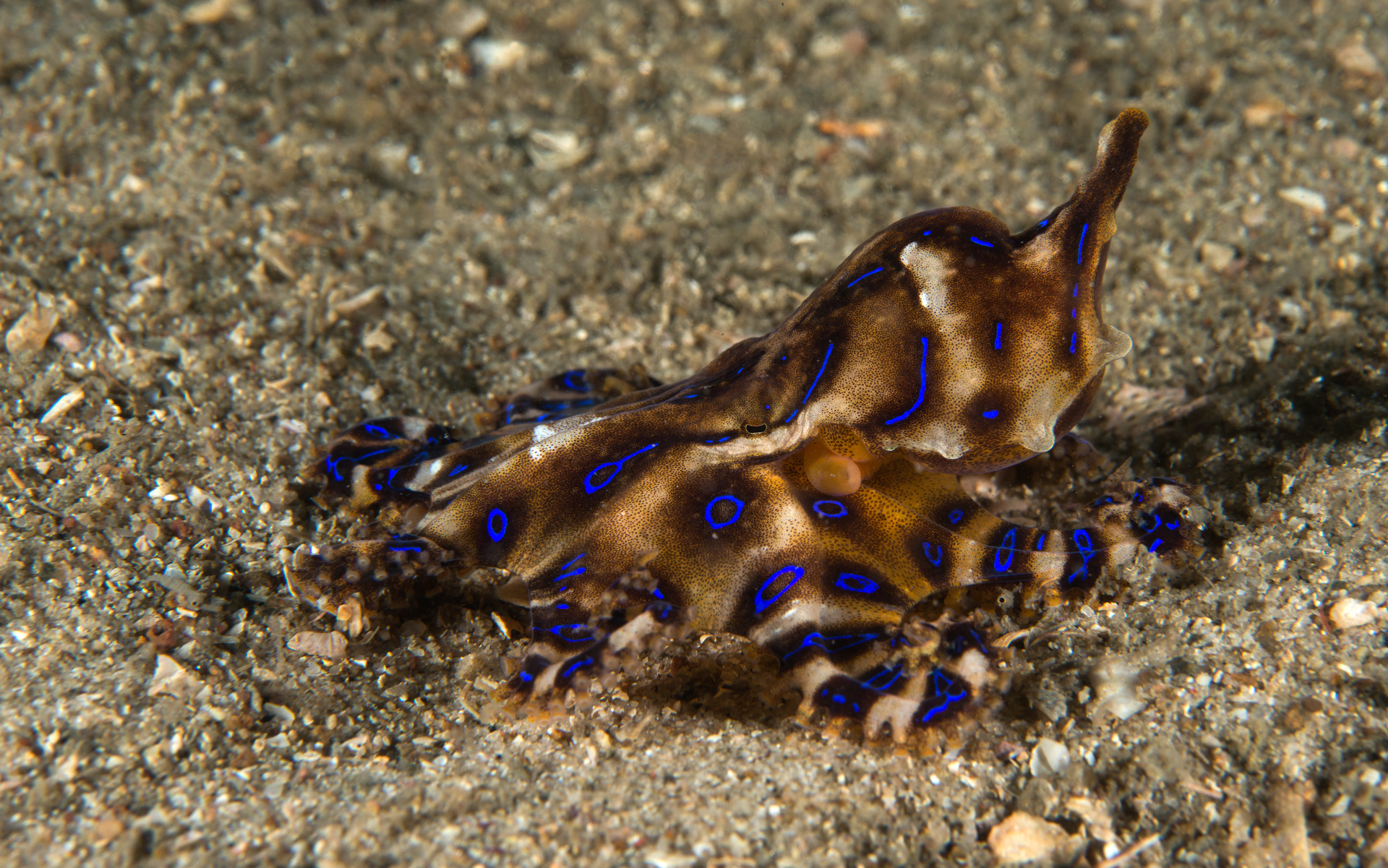Behaviors of the Venomous, Blue-Lined Octopus
This venomous octopus packs a punch, but it’s more likely to hide than launch a poisonous attack.

A blue-lined octopus ("Hapalochlaena fasciata"), one of four described species of blue-ringed octopus species. Photo by Julian Finn, Museum Victoria
The venomous cephalopod above has a bit of a reputation—of 280 described octopus species, it’s probably one of the deadliest to humans. It contains a type of neurotoxin throughout its body called tetrodotoxin (the same as what’s found in puffer fish), which causes paralysis in bite victims by disrupting communication between nerves and muscles. Unable to breathe, a sufferer can die.
Yet, while this particular species—a type of blue-ringed octopus called Hapalochlaena fasciata—has caused one known death in Australia, where the animal is found, it’s generally a pacifist. “They are dangerous, and people need to be educated about them, but they’re not out hunting humans or trying to bite us,” says Julian Finn, senior curator of marine invertebrates at the Museum Victoria in Melbourne. He would know: “I’ve observed hundreds of blue-ringed octopus underwater, and none of them have ever tried to attack me; they’ve all been going about their business.” (The victim who died, back in 1967, had taken the octopus out of the water, according to Finn.)
Also known as a blue-lined octopus (for the cobalt streaks on its body that match the rings on its arms), H. fasciata is one of four described blue-ringed octopus species. Based on specimens collected throughout the Indo-Pacific, however, there are probably 15 more species that have yet to be named, according to Finn, who has been studying the group for three years.
Although H. fasciata is common along Australia’s eastern coast, casual swimmers tend to overlook it because it’s typically camouflaged to blend into its surroundings, according to Finn. Like its well-studied brethren, it only seems to reveal its cool coloring when it’s threatened or angry—and it does so by relaxing its muscles to expose structures called iridophores, which reflect blue-green light. To enhance the effect, the cephalopod darkens the skin surrounding the iridophores, resulting in a dazzling iridescent blue pattern that probably best translates to “back off.”
Yet, blue-ringed octopuses like H. fasciata don’t seem anxious to wield the toxic bite advertised by their colorful bark. When hunting, for instance, they appear to rely more on stealth to attack prey, such as crabs, rather than immediately subduing it with venom (injected by biting), according to Finn. “They tend to just grab prey that they can handle, and they can handle it really quickly, and there’s no indication that they’re using their venom,” he says.
Aside from its seeming reluctance to wield poison, H. fasciata has another quirk: Males don’t appear capable of distinguishing between sexes. “You would think that an animal, with such amazing ability of color change, would convey [their sex] to the other members of their population, but they don’t,” Finn says. Mating thus becomes a bit of a crapshoot, with males lusting after both sexes. “They just have no clue when it comes to spotting the girls,” says Finn.
The mating process is even more theatrical given the fact that males also have a physical handicap, so to speak. In octopus species, males have a modified arm that they use to deliver a packet of sperm into a female’s oviducts, which are located in a space in her sack-like body called the mantle cavity (“essentially, he hands [the sperm] to her,” says Finn). In the well-studied blue-ringed octopus species, that reproductive arm is shorter than the other arms, which means that a male needs to grab onto a female in order to successfully insert the sperm. As a result, if a male H. fasciata mistakenly latches onto another male, “it’s not until he’s actually got his reproductive arm inside the mantle cavity [that] he goes, ‘Oop! Sorry—you’re a bloke!’” says Finn. He then lets go of the embrace and keeps on trying until he gets it right.
The inability to discern among sexes has been observed in another species of blue-ringed octopus in an aquarium setting, but Finn has witnessed the behavior firsthand among H. fasciata in the wild. “They must have greater success just by grabbing every other blue-ringed octopus that goes past as opposed to wasting time trying to distinguish,” he says. “It must be working for them.”
With every donation of $8 (for every day of Cephalopod Week), you can sponsor a different illustrated cephalopod. The cephalopod badge along with your first name and city will be a part of our Sea of Supporters!
Julie Leibach is a freelance science journalist and the former managing editor of online content for Science Friday.